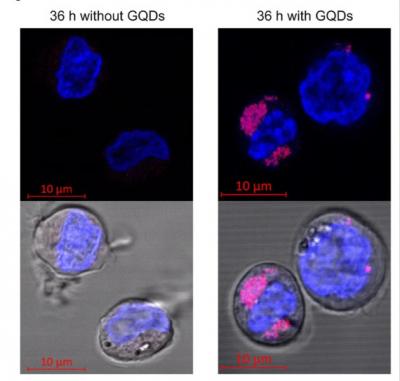A team of researchers from the Physics, Medicine and Chemistry departments at Heinrich Heine University Düsseldorf (HHU) has examined if graphene nanoparticles are potentially dangerous for the organism and how cells cope with them once they have been incorporated.
 microscopy images of living cells cultured for 36âh without GQDs (left) and with GQDs (right) as observed (top row) and merged with the bright field images (bottom row)
microscopy images of living cells cultured for 36âh without GQDs (left) and with GQDs (right) as observed (top row) and merged with the bright field images (bottom row)
Nanoparticles can be absorbed in body cells, and two aspects to this feature exist. First, it makes nanoparticles good vehicles for transporting a broad range of compounds or substances attached to them into normal diseased cells in a targeted manner. On the other hand, they can also pose health risks.
The researchers used nanoparticles made from graphene; They added these to special haematopoietic stem cells referred to as CD34+ stem cells. These cells are particularly sensitive to damaging environmental influences on account of their ability to divide throughout their lifespan. The assumption is that these cells would be damaged more by nanoparticles if at all than the more robust other cell types.
The interdisciplinary team of researchers was able to demonstrate that the carbon nanoparticles get into the cells, where they are encapsulated in special organelles called lysosomes. The lysosomes serve as a type of waste removal unit for the body where foreign bodies accumulate and are normally broken down with the help of enzymes. However, the researchers didn’t observe any such process over the duration of the experiments, which lasted for several days.
When comparing the active genes (gene expression) of stem cells with and without the addition of nanoparticles, the researchers found that only one of a total of 20,800 recorded expressions had changed; minor effects were determined in a further 1,171 gene expressions.
Prof. Heinzel commented regarding the findings: Encapsulation of the nanoparticles in the lysosomes ensures that these particles are stored securely at least for a few days for the duration of our experiments and cannot damage the cell. This means the cell remains viable without any major change in gene expression. This insight is important if nanoparticles are to be used to deliver drugs into the cell. The experimental framework used here does not allow for any long-term statements to be made regarding any increased probability of cell mutation resulting in cancer.